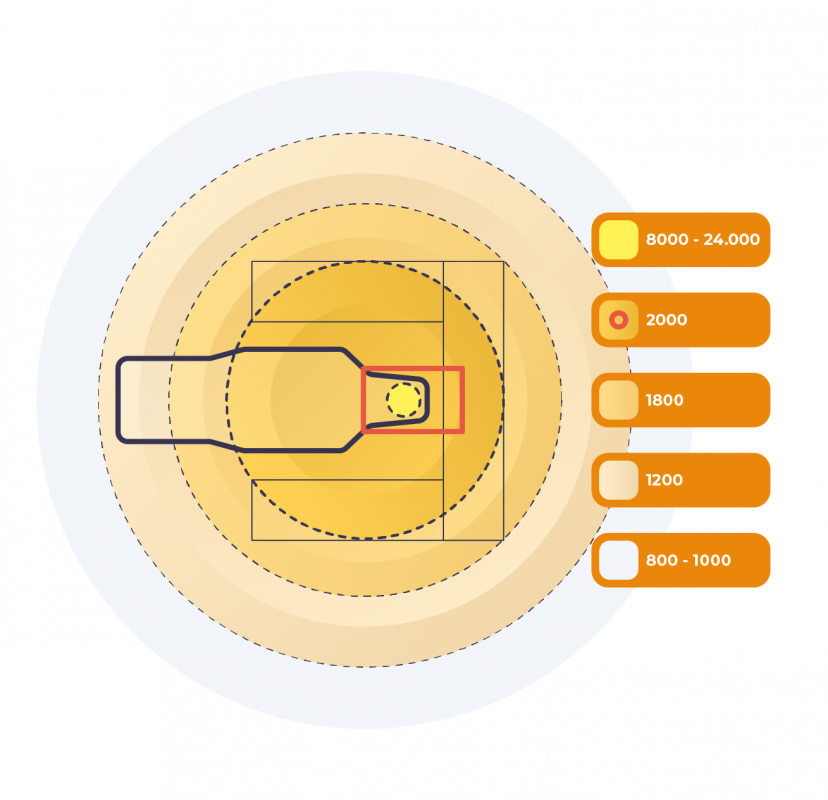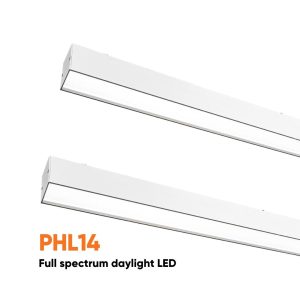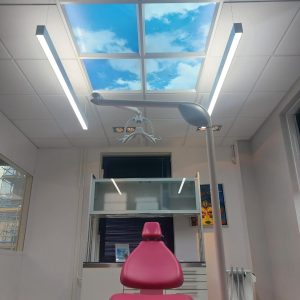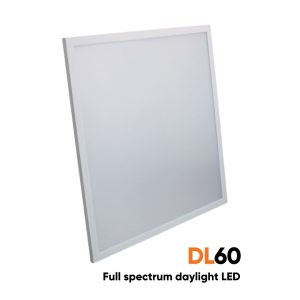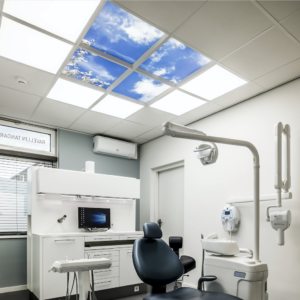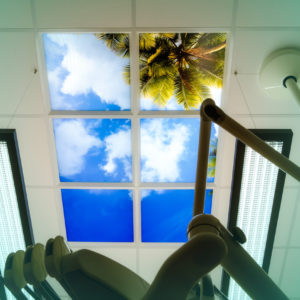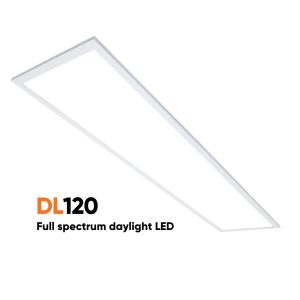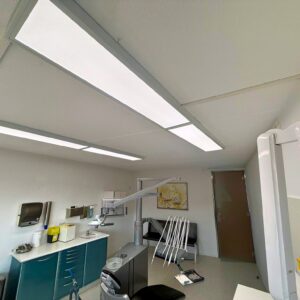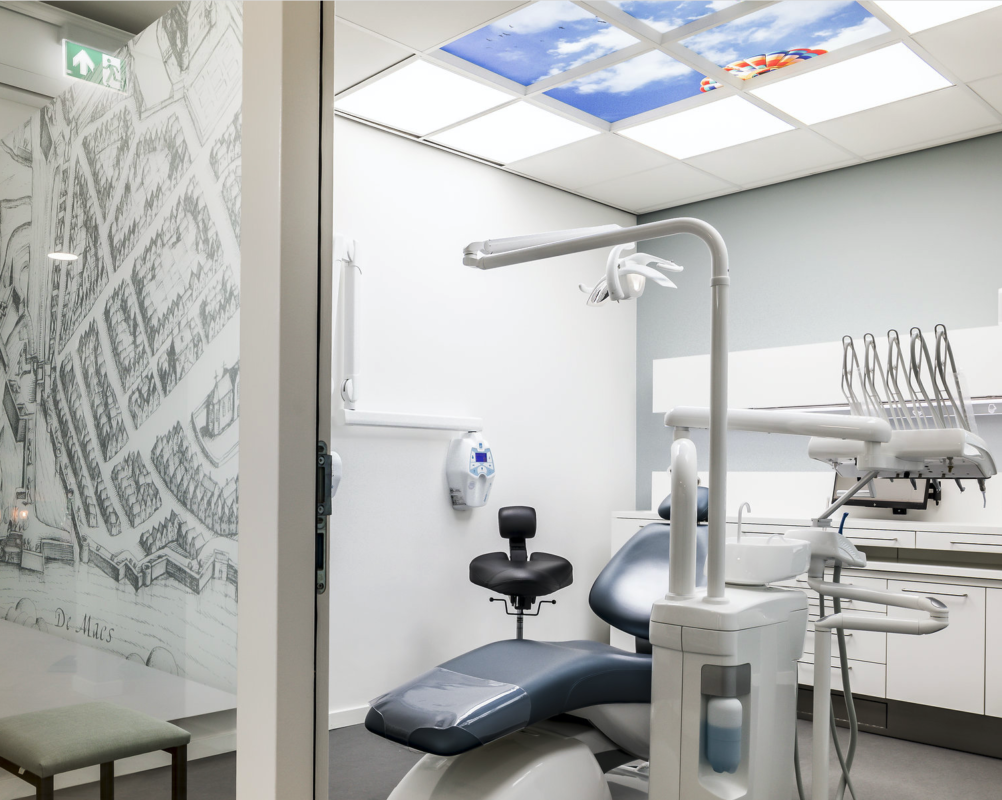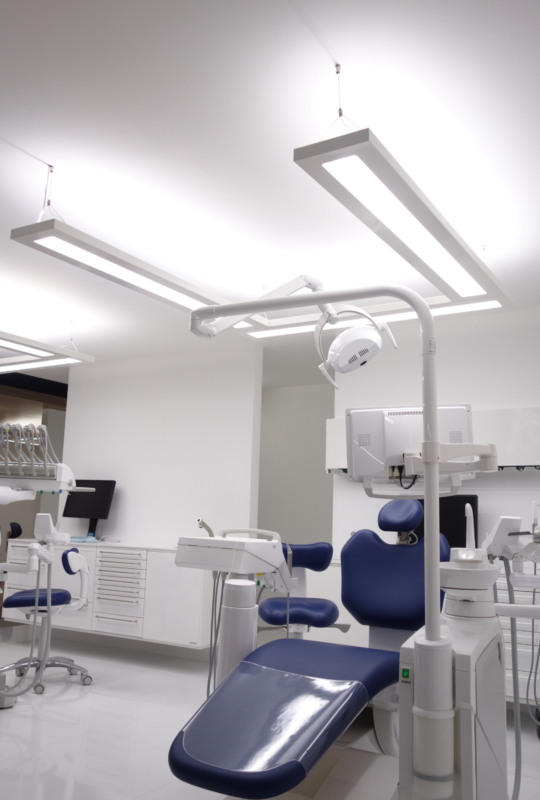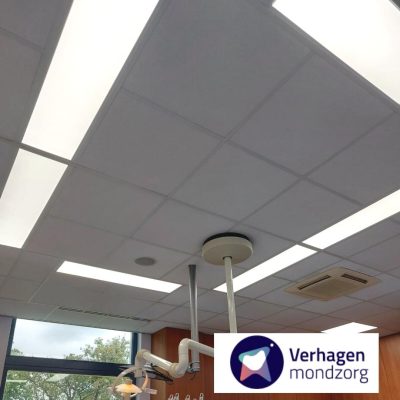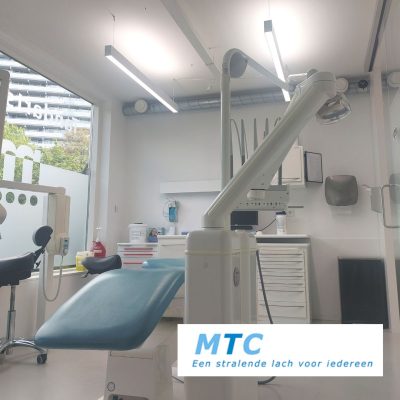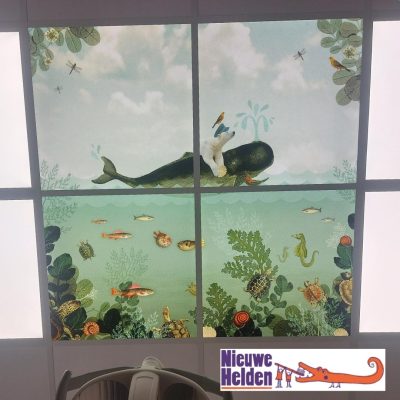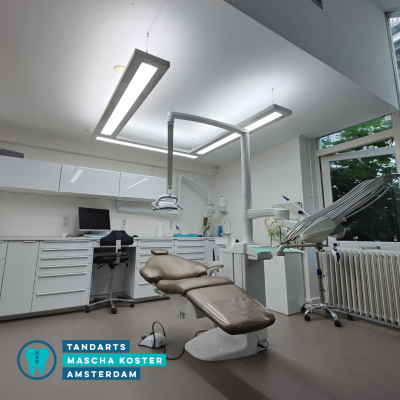Lighten up your work, optimise LED lighting in your dental clinic
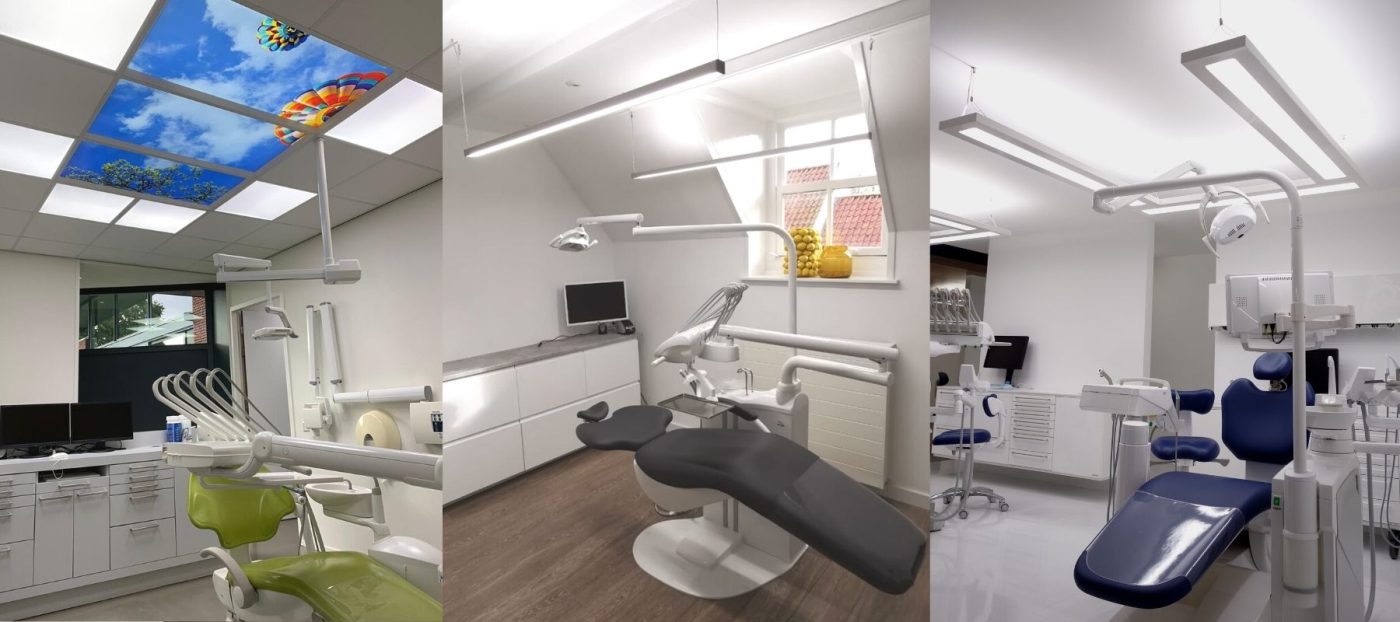
Dentled stands for uncompromising quality in dental clinic lighting. The specific needs for dentist’s workplace lighting, e.g. orthodontists, dental hygienists, oral surgeons, implant dentists, dental technicians and prosthodontists are our main focus.
The proper lighting for your dental practice increases your productivity, contributes to the health of you and your employees and thus creates a comfortable working environment.
On this page you can read more about quality dental clinic lighting and why it is important to invest in good light for your team and patients.
The right luminance
The ratio of 10:1:0.5 can be used for optimal lighting at a dental workplace. This is the ratio between oral cavity illumination by a surgical lamp (20,000 lux for most dentist’s lamps, newer surgical LED lights often reach even higher values up to 55,000 lux), the direct vicinity of the mouth (2,000 lux) and the illuminance in the rest of the treatment room (800-1,000 lux).
Common complaints as a result of incorrect work field lighting:
- burning eyes
- fatigue
- concentration problems
- unable to determine color well
- poor contrast display
For more information email: info@dentallighthouse.eu or call us at +31 30 3100 500
Workplace
Every room has different requirements depending on their use, size and colour scheme of walls and ceilings. These factors have a direct influence on the amount and the wattage of daylight LED luminaires to be installed in the room in question. Dentists, oral hygienists and dental technicians work in a relatively small work environment and should take into account the following factors that influence the right choice for general work lighting.
Amount of light
For common workplaces (offices) a guideline of 500 lux is applicable in the workplace. As a dentist works with an operating light with an average of 20,000-25,000 lux, the “tunnel effect” should be avoided by increasing the overall workplace lighting to at least 2000 lux. Especially since newer surgical lights often have an even higher light intensity (20,000-55,000 lux).
In order to be able to realise the 2000 lux indicated for dental workplaces, one generally needs higher wattages than luminaires for offices or schools provide. Dentled armatures therefore have a considerably higher wattage than regular lighting fixtures so that the desired lux value of 2000 can be easily achieved.
There is a lot of confusion about concepts in the world of lighting. Many suppliers of LED lighting use the terms lux and lumen interchangeably. The result may be that end users unknowingly buy the wrong lighting or compare products that are completely different.
See below a few dental clinics with Dentled Full spectrum daylight which comply to the dental office standard. In the direct vicinity of the mouth (2,000 lux) and the illuminance in the rest of the treatment room (800-1,000 lux).
What are lumens?
Lumen is the sum of all the light emitted, regardless of the direction in which it is emitted. Lumen, like lux and candela, is a so-called photometric unit which means that the human eye is taken into account when determining the amount of lumen emitted by a light source.
This is necessary because some people can see one colour better than another. If we were to power a light source with one Watt and it emits one colour, for example 550 nm (green), then this light source emits 683 lumens. If we use the same energy in a light source that emits 650 nm (orange), then this light source will only emit 73 lumens.
Different shades of warm white, with the same amount of Watt, can result in greatly varying amounts of lumens. Consequently, in addition to wattage you must also take colour temperature (Kelvin) into account.
What are lux?
This also is a unit of light intensity. The amount of lux indicates how much light (lumen) reaches a certain surface. Actually, you can learn more from the lux value than the amount of lumen. This is why guidelines in the lighting field are best expressed in terms of the amount of light in lux that is needed at a specific location. However, in advance you can never indicate the amount of lux per luminaire exactly. This is because the lux value of a specific location is related to all factors of the encompassing room (e.g. size, colour composition).
What is the difference between lumen and lux?
The conclusion is: lumens represent the light intensity of a light source, measured at 1m distance. Lux stand for the light intensity measured at the work surface.
Why are lux so important?
The amount of lux are important to be able to reach the desired light intensity for discerning tasks. For a given task, the available light intensity can suffice or not. Precision and detail work already requires a lot of light. Even more luminance is needed for dental work. This is because the transition from the ambient light to the light beam of a surgical light which illuminates the mouth should not exceed a ratio of 10:1. This way the eyes have an acceptable transition when turning the head away from the light beam. With modern dental operating LED lights, the brightness can be set in a range from 8,000 to 55,000 lux.
How are lux measured?
The lux value is determined by the number of candelas. The word ‘candela’ is derived from Latin and means candle. One candela approximately corresponds to the illuminance level of one ordinary candle. One lux corresponds to the illuminance of one candela for a surface.
You can measure lux with a lux meter. When realising a whole room you can use lighting calculation software to determine lux values.
Lux should be measured at the working area. In case of a dentist this is at the headrest of a treatment chair in treatment position.
Light distribution
Every room has different requirements for the arrangement and placement of lighting based on its use, dimensions and colours of walls, floors and ceiling. For rooms with high ceilings, it may be advisable to adopt direct and indirect lighting. This can be done by hanging a direct/indirect fixture from steel wires where the light will radiate both upwards and downwards. Correct light distribution is achieved through the reflection on the walls and ceiling. The transitions of brightness in the room will consequently smoothen out. Dentled panels are equipped with prisms which provide a wide angle of light distribution by which an optimal light distribution occurs in most situations. An optimal light distribution can be described as gradual transitions of the light intensity in a room.
Light source
For human beings as well as animals natural daylight provides the best light for perception. After all, we need daylight as evolution has formed our species in the open into the human which now dwells on earth. Even though humans are not meant to live inside for extended periods of time, this is exactly what has happened. To function and perceive at one’s best in an unnatural surrounding, daylight at the workplace is recommended.
Colour temperature tells us something about the colour of the light emitted by a lamp. This is mostly expressed in Kelvin (K). The lower the amount of Kelvin, the redder the light. The higher the amount of Kelvin, the bluer the light. Candlelight for example has a colour temperature of approximately 2000 Kelvin, a halogen lamp usually around 2800-3000 Kelvin and (full-spectrum) daylight 5800-6500 Kelvin.
Dentled daylight LED lamps simulate daylight. These daylight lamps emit all colours which natural daylight is comprised of. The ratio of all of these colours/frequencies is mimicked by Dentled. The (CRI) colour rendering or Ra is a standardised scale from 0 to 100 in which 100 is equal to actual daylight. Daylight is composed of various colours of the entire colour spectrum. The Ra value indicates the extent to which the colours are present at the light source. Ra 80 contains 80% of the colours, meaning the light source could contain less green than Ra 90. The RA value of Dentled is 93.5. Therefore Dentled can be called full spectrum daylight.
Because our eyes don’t have to adapt in a daylight environment the eye’s “task” is significantly relieved. This results in an immediate reduction in the energy spent of by the respective dental hygienist or dental technician. Dentled lighting is therefore experienced as a calm, pleasant light despite the high amount of lux it guarantees in a treatment room.
In addition, daylight is ideal for colour determination (it’s not uncommon to walk out of a shop to determine the colour of a garment in daylight). Daylight also stimulates vitamin D production.
Drivers
In LED lighting you can find between flicker-free and non flicker-free LED Lighting. But, what’s the difference?
Non flicker-free LED lighting is powered by a (standard) 50 Hz driver (50 flashes per second). We perceive these flashes consciously or unconsciosly. As a result the eye has to work hard to process these flashes.
Many people experience work in 50 Hz driven lightning as exhausting and can even suffer from burning eyes or headaches.
Flicker-free drivers have a considerably higher amount of Hertz, that cannot be perceived by us anymore. Accordingly, the emitted light is very constant and our eyes do not notice the flashes anymore. This in turn will save the eye of a dentist, dental hygienist or dental technician a great deal of energy. That is why this flicker-free light is perceived as calm and pleasant.
Recommended lighting levels (EN 12464-1)
The European lighting regulation EN 12464-1 (CIBSE Code for lighting) contains the recommended lighting levels for all workplaces.
Guidelines for appropriate lighting
In order to gain insight into the recommended level of illuminance to be achieved, the table below gives an indication of which illuminances apply to a variety of tasks and spaces. The lighting standard EN 12464-1 specifies the requirements that must be taken into account when designing a lighting installation.
Type of lighting
|
Type of lighting |
Type of room |
Standard illuminance (lux) |
|
|
Orientational lighting |
Storage spaces, parking garages, hotel entrances |
50 to 100 |
|
|
Hallways, stairwells, elevators, bathrooms, church rooms, halls and lobbies |
100 to 200 |
||
|
Work lighting |
construction work, warehouses, living rooms, fairs, exhibitions |
200 to 375 |
|
|
Offices, classrooms, assembly lines, kitchens, supermarkets |
400 to 750 |
||
|
Technical drawing rooms, precision assembly work |
800 to 1500 |
||
|
Specialised work lighting |
Precision work with fine details |
1600 to 3000 |
|
|
Inspection work, operating tables |
3200 to 6000 |
||
Making a lighting plan
The walls, floor and ceiling of treatment rooms are generally kept in bright, white colours. The brighter the colours the less light is absorbed and the better the reflection of light. If the treatment room has grey, dark walls and floor it will influence the amount of required Dentled panels.
Dental Lighthouse has special light calculating software so we can easily create a lighting plan for you.
A lighting plan will offer insight into:
- the influence of the colour composition in a room
- the amount of Dentled panels to be installed
- the ideal position of luminaires to be installed
- the possibility/necessity of direct/indirect lighting
- the general light distribution
- the luminance / Lux at the workplace (80cm off the ground)
email: info@dentallighthouse.eu or call us at +31 30 3100 500
